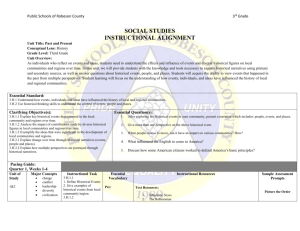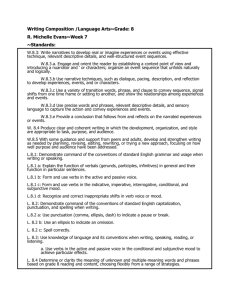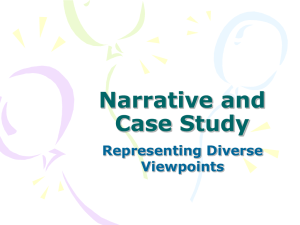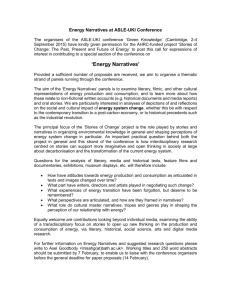IS-126 syllabus - Westmont College
advertisement
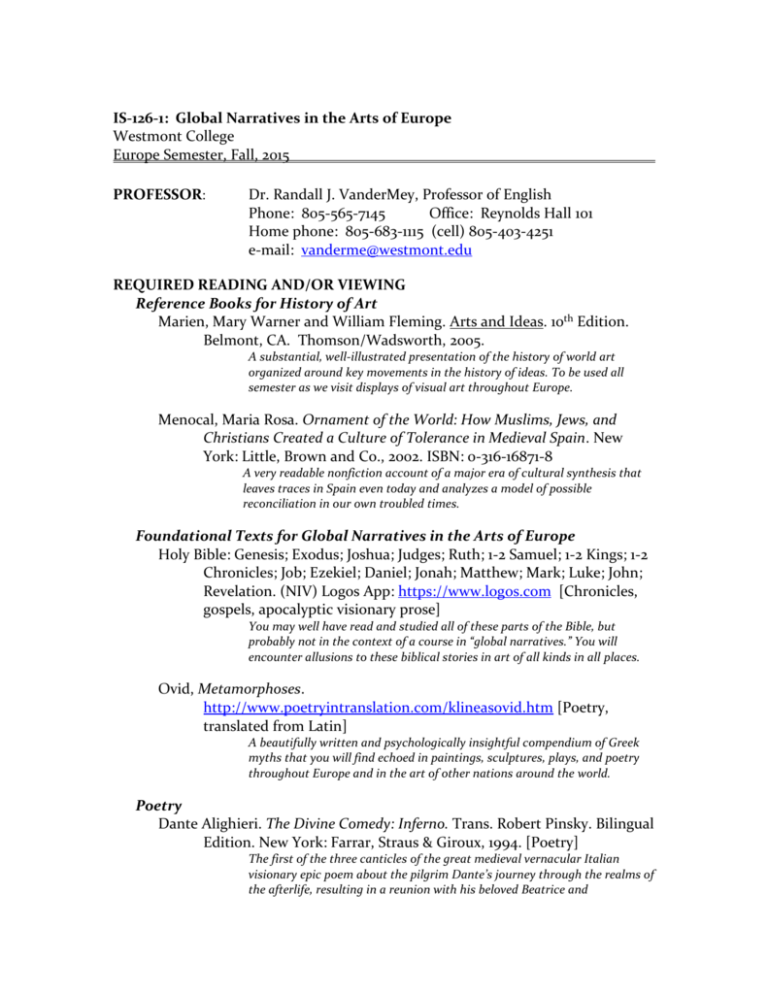
IS-126-1: Global Narratives in the Arts of Europe Westmont College Europe Semester, Fall, 2015 PROFESSOR: Dr. Randall J. VanderMey, Professor of English Phone: 805-565-7145 Office: Reynolds Hall 101 Home phone: 805-683-1115 (cell) 805-403-4251 e-mail: vanderme@westmont.edu REQUIRED READING AND/OR VIEWING Reference Books for History of Art Marien, Mary Warner and William Fleming. Arts and Ideas. 10th Edition. Belmont, CA. Thomson/Wadsworth, 2005. A substantial, well-illustrated presentation of the history of world art organized around key movements in the history of ideas. To be used all semester as we visit displays of visual art throughout Europe. Menocal, Maria Rosa. Ornament of the World: How Muslims, Jews, and Christians Created a Culture of Tolerance in Medieval Spain. New York: Little, Brown and Co., 2002. ISBN: 0-316-16871-8 A very readable nonfiction account of a major era of cultural synthesis that leaves traces in Spain even today and analyzes a model of possible reconciliation in our own troubled times. Foundational Texts for Global Narratives in the Arts of Europe Holy Bible: Genesis; Exodus; Joshua; Judges; Ruth; 1-2 Samuel; 1-2 Kings; 1-2 Chronicles; Job; Ezekiel; Daniel; Jonah; Matthew; Mark; Luke; John; Revelation. (NIV) Logos App: https://www.logos.com [Chronicles, gospels, apocalyptic visionary prose] You may well have read and studied all of these parts of the Bible, but probably not in the context of a course in “global narratives.” You will encounter allusions to these biblical stories in art of all kinds in all places. Ovid, Metamorphoses. http://www.poetryintranslation.com/klineasovid.htm [Poetry, translated from Latin] A beautifully written and psychologically insightful compendium of Greek myths that you will find echoed in paintings, sculptures, plays, and poetry throughout Europe and in the art of other nations around the world. Poetry Dante Alighieri. The Divine Comedy: Inferno. Trans. Robert Pinsky. Bilingual Edition. New York: Farrar, Straus & Giroux, 1994. [Poetry] The first of the three canticles of the great medieval vernacular Italian visionary epic poem about the pilgrim Dante’s journey through the realms of the afterlife, resulting in a reunion with his beloved Beatrice and VanderMey—IS-126-1 “Global Narratives in the Arts of Europe” Syllabus EuroSem 2015 2 culminating in a mystical vision of God. The reading will correspond with our sojourn in Dante’s home city, Florence, Italy. Fiction Doblin, Alfred. Berlin Alexanderplatz: The Story of Franz Biberkopf. Trans. Eugene Jolas. New York: Continuum, 1961; 2004. ISBN: 0-8264-77895 A masterpiece of German literature and the first to adopt the stream-ofconsciousness techniques of the Irish genius, James Joyce. A study of fate in an environment of poverty, crime, and rising Nazism in 1920s Germany. Dostoevski, Fyodor. Notes from Underground. Trans. Michael R. Katz. Norton Critical Edition. NY: W.W. Norton & Co, 1863; 1989. A harsh and darkly satirical study of grace, free will, love, and the oppressiveness of the Russian bureaucracy by one of the greatest Russian novelists. Hesse, Hermann. Siddhartha, Demian, and Other Writings. New York: Continuum, 1951; 2001. A highly popular Bavarian writer, writing in German translated into English, studies the religious cross-currents between Eastern and Western religious systems as he retells the story of the initiation and spiritual journey of Siddhartha Gautama. Laforet, Carmen. Nada. Trans. Edith Grossman. New York: The Modern Library, 1945; 2008. ISBN: 978-0-8129-7583-3 The first novel by a precocious 24-year old Spanish writer who tells the story of a young girl’s move from rural Spain to the strangely complicated family life among relatives in 1942 Barcelona. Levy, Andrea. Small Island. New York: Picador, 2004. ISBN: 978-0-31242952-2 An internationally bestselling novel humorously and honestly probing the struggle of a Jamaican couple’s struggle to assimilate in post-WWII London against barriers of race, class, and circumstance. Matar, Hisham. Anatomy of a Disappearance. New York: Random House, 2012. The author, a Libyan living in exile in London, who read live to audiences at Westmont three years ago, writes about a young Libyan boy’s struggle to make sense of life in the absence of his father, who was kidnapped by Col. Muammar Gaddafi’s security agents. Shafak, Elif. The Bastard of Istanbul. New York: Penguin, 2007. ISBN: 9780-14-311271-6 A lyrical novelist traces the experience of an Arizona woman who divorces her Armenian husband and marries into a Turkish family to get back at him, thus opening the story upon the dark history of the Turkish people’s genocide against the Armenians early in the 20th century. VanderMey—IS-126-1 “Global Narratives in the Arts of Europe” Syllabus EuroSem 2015 3 Memoir Levi, Primo. The Periodic Table. New York: Random House, 1984. A literarily written memoir of a Jewish family’s culture and struggles in the first half of the 20th century in Europe. Drama Frayn, Michael. Copenhagen. New York: Anchor Books, 1998; 2008. See Movie version: https://www.youtube.com/watch?v=4hGAq2kc6u0 A celebrated play about the difficulties of the historical conversation between two nuclear physicists, the Dane Niels Bohr and the German Jew Werner Hiesenberg, over the physics that contributed to the invention of the atomic bomb. Mayorga, Juan. Way to Heaven. Trans. David Johnston. Oberon Books, 2006. ISBN-13: 9781840025774 ISBN-10: 1840025778 A Spanish playwright’s treatment of the manipulation of the international Red Cross by the Nazi overseers of the Teresienstadt Concentration Camp some distance from Prague, then-Czechoslovakia. McBurney, Simon. A Disappearing Number. Theatre De Complicite. 1st Edition. London: Oberon, 2008. ISBN: 978-1-84002-830-0 A multi-media play in which a scholar investigates the story of a precocious young Indian mathematician who was championed by a Cambridge University don. Film Fitzcarraldo [1982]. Dir. Werner Herzog. Starring Klaus Kinsky, Claudia Cardinale. A movie directed by one Germany’s most prolific and daring contemporary filmmakers, Werner Herzog, in which a mad German visionary enlists native help to try to build an Italian opera house deep in the Brazilian jungles. To reach his destination he has to attempt the nearly impossible: to drag a huge steamship over a mountain. Triumph of the Will [1935] Dir. Leni Riefenstahl. Starring Adolf Hitler. https://www.youtube.com/watch?v=b0kwnLzFMls The award-winning Nazi propaganda film by a German film director, producer, screenwriter, editor, photographer, actress and dancer who died in 2003 at the age of 101. WHAT IS “IS-126-1, Global Narratives in the Arts of Europe”? This course is a semester-long engagement with global narratives in fiction, poetry, drama, film, visual arts, and music, on the 2015 Europe Semester. Narratives are renderings of events as carefully crafted stories. The phrase ”Global narratives” can mean several things: VanderMey—IS-126-1 “Global Narratives in the Arts of Europe” Syllabus EuroSem 2015 4 1) stories that have come to have universal popularity and influence, such as the Italian poet Dante’s Divine Comedy or the ancient poet Ovid’s tellings of Roman myths in Metamorphoses, not to mention the stories in the Bible. 2) stories that emerge from globally significant conflicts, such as Simon McBurney’s play Copenhagen, that emerges from the German and Danish scientific research that led to the development of the atom bomb in WWII 3) stories that represent one cultural perspective on events that would be interpreted quite differently from an opposing cultural perspective, such as the the Bayeux Tapestry’s Norman (French) depiction of the Norman Conquest of England in 1066, or Primo Levi’s memoir of Jewish life in Europe during a century of war. Since our travel in Europe will bring us to at least 11 countries, from Scotland to Rome, we will have many encounters with art in all of these media, art ancient and contemporary, sacred and secular, popular and academic, amateur and professional, state-sponsored and subversive, traditional and experimental. We will see cathedrals, plays, art galleries, folk dances, concerts, readings, street musicians, public ceremonies, enactments of liturgies, modern dances, and much more. To bring order and sense out of this wealth of experience, IS-126-1 focuses on one of the great common denominators of the arts: the mode of narrative. By narrative, we mean the drive and craft that shape the telling of events into a story. By focusing on narrative, we can teach ourselves to pay keener attention to detail in the arts, and to understand five aspects of all the arts—purposes, principles, preparations, performances, and perspectives. Some of the stories we encounter will be ancient: renderings of classical myth, folklore, epics, tellings and retellings of European history. Some will express the order of medieval Christian devotion or the struggles of early modern nation-building. Some will embody the values and ideals of Renaissance humanism, some will serve the ends of Modern rationalism, some will advance or resist the causes of Romantic revolutions, and some will reflect the decadence, the commercial interests, the utopian dreams, or the violent conflicts that so strongly marked the 20th century in European life. Some will reflect the daily lives of European peoples, and some will reflect the world of global influences that have flowed through European markets and systems of value. For a fuller grasp of narrative at work in the arts, we will devote part of our study to the history of the arts and artistic ideas in Europe, part of it to theories of narrative, part of it to critiques of artistic presentations, and part to creative productions on the parts of students—productions ranging from theatrical improvisations to expressive movement to readings or displays of original work in writing or visual art. GOALS FOR STUDENTS The primary goals for this course are consistent with the goals for General Education (GE) courses in the Common Inquiries section under the headings VanderMey—IS-126-1 “Global Narratives in the Arts of Europe” Syllabus EuroSem 2015 5 “Performing and Interpreting the Arts” (II. 4. in the G.E. program) and “Thinking Globally.” Here is wording from the “Description of General Education Program”: Thinking Globally. Changes in economic, political and environmental conditions are contributing to an increasingly interdependent and connected world. Students will study cultural, religious, political or economic practices with an eye to appreciating interactions between people from different ethnicities and world contexts. In the process, they will better understand other perspectives and world views---extending beyond those rooted in “Western” experiences—and will appreciate the deep influence of culture on the categories one uses to understand the world. Acquiring a global perspective equips students to be informed agents of redemption and justice in a rapidly changing world. Performing and Interpreting the Arts. Students will expand their understanding of the fine arts and performing arts, including music, visual arts, theatre, or dance. Students will develop and expand perceptual faculties, develop physical practices integral to the art form, and explore the critical principles which guide artists in the area. Specifically, you will: • develop and expand your perceptual faculties (viewing art and drama, listening to other’s stories, • develop physical practices integral to various art forms • explore and come to understand critical principles that guide artists in a variety of media. The major secondary goals fulfill some of the stated purposes of the Europe Semester program. Specifically, you will • integrate academic and experiential aspects of your education. • broaden your perspectives on your own academic discipline through interdisciplinary study and creative production • broaden your faith by discovering how others of different faiths have expressed themselves in art • discover and clarify a sense of calling by measuring your own critical and creative faculties against models in European culture. IS-126-1 is designed for non-experts in the arts, and so it has no prerequisites beyond the usual for participants on the Europe semester. COURSE ACTIVITIES READ Summer assignments in textbooks (to be announced in Spring, 2015) Historical writings (chiefly during summer, 2015) Concert programs (during our travels, at scheduled and unscheduled events) Novels and poetry (both before the trip and during it) Scripts (for selected plays) Movies (during summer 2015] Written display material—historical markers, etc. (on site in Europe) VanderMey—IS-126-1 “Global Narratives in the Arts of Europe” Syllabus EuroSem 2015 6 Internet sites (prior to departure and in Europe) Advertisements (on site in Europe) Newspapers (on site in Europe) VIEW Critique plays at the following locations: Edinburgh Fringe Festival, London (possibly New Globe, NT, and other venues), Stratford-on-Avon Art gallery searches and critique of individual works: Tate and Tate Modern, Louvre, Rijksmuseum, Prado, Sistine Chapel, etc. Public monuments such as Trajan’s Column in Rome (and at a variety of sites) Architectural sites—e.g., Coventry, Westminster Abbey, Notre Dame, Chartres, Versailles, Brandenberg Gate, Auschwitz,etc. Museum Displays (e.g., Caen Peace Museum, Resistance Museum in Amsterdam, D-Day Museum at Arromanche, Bayeux Tapestry, etc. INTERVIEW Locals re. local lore Actors, directors, musicians, journalists (if possible) LISTEN Symphony performances in London, Berlin, Vienna Open air concerts Debates in Hyde Park (London) DISCUSS Readings Plays, concerts, and performances Situational insights (with partners, small groups, and whole class) Student projects in development Museums, cathedrals, historical sites, brochures, radio and tv broadcasts, Advertisements, photographs Monuments Theory questions Narrative implications of other classes on EuroSem WRITE Synopses of and responses to summer readings Keep a narrative journal, collecting narrative threads and ideas about global narratives Analyze historical presentations in museums and historical sites such as Edinburgh Castle, Warwick Castle, Coventry Cathedral, Canterbury, Normandy Coast, Amsterdam Resistance Museum, NATO headquarters in Brussels, Jewish Quarter in Prague, Concentration camps in Germany, Czech Republic and Poland, Vatican Synthesis paper (major project on narrative, containing a narrative of your experience with narrative, with meta-narrative commentary) Essay of Reflection and Self-evaluation on creative project VanderMey—IS-126-1 “Global Narratives in the Arts of Europe” Syllabus EuroSem 2015 7 ORAL PRESENTATIONS Reading of original poems, stories or libretti Oral Exam: Evaluation of narrative journal and creative project, and discussion of Synthesis Paper CREATIVE PROJECTS AND PRESENTATIONS Possibilities: • Compose a fictional narrative with a globalized perspective and read it to the group • Compose and sing or play music that synthesizes Western and nonWestern traditions • Present a slideshow of photographs you’ve taken that tell stories containing global inflections • Interpret a story in dance before the group • Create group tableaux drawing upon materials in our reading list • Collaborate with others on inventing and staging a multi-media multicultural journey story • Do an interpretive reading or reader’s theater of material drawn from our reading list • Use a cell phone or ipad or video camera to film and edit a story • Write and read to an audience a sequence of poems in which global influences are at work ACT Theatrical improvisations (guided) in class What Are Some of the Recurrent, Underlying Questions in the Course? 1. What is narrative? What are the main ingredients of narrative? How are narratives framed and structured? What are the conventions of narrative? 2. Where does the impulse toward narrative come from? 3. How does the master narrative of Christianity interact with other narratives in European history and contemporary culture? 4. Who shapes narratives and toward what ends? 5. What is the psychology, the politics, and the sociology of specific narratives that you encounter? 6. What global narratives are embedded in images and artistic representations, and how? 7. What power is lodged in or channeled through artistic narratives? 8. What are some of the prominent global narratives in European culture, past and contemporary (e.g., stories of conquest, stories of migration, stories of confrontation and synthesis, stories of discovery, stories of rescue, etc.)? How are these reflected in the arts? 9. Who is excluded from certain global narratives? How do narratives frame issues of gender, race, and economic privilege? 10. How are counter-narratives generated? What happens when narratives meet counter-narratives? 11. What happens to artistic narratives in postmodern culture? VanderMey—IS-126-1 “Global Narratives in the Arts of Europe” Syllabus EuroSem 2015 8 12. How should a Christian “read” and “critique” difficult narratives, as they are employed in the arts? What Specifically Am I Required to Do in the Course? You must: 1. Keep a narrative journal throughout the semester, filling it out in ways that will be prescribed in detail before the beginning of Summer, 2015. You may expect to include such writings as the following: a) synopses of plays, novels, poems, historical accounts, etc. b) records of interviews with people you meet in Europe, c) reflections on questions posed by the instructor in transit, d) exploratory analyses of plots, tales, designs, librettos, e) lists of story motifs, f) sketches of narrative structures and rhetorical relationships within narratives, etc. [Worth 20% of final grade] 2. Read assigned background readings before the end of Summer 2015 and give account of your readings in summaries, as the instructor will require. [Worth 10% of final grade] 3. Participate in standing discussion groups (5-7 members each); present two analyses to the whole group, focusing on global narrative elements you encounter in artworks along the route. [Participation grade worth 10%] 4. Complete a major project consisting of a synthesis paper in which you draw together materials you’ve gathered in all the countries you will have visited and discuss larger questions about global narratives [Worth 30% of final grade] 5. Present a creative project to the group, worked out in collaboration with members of the discussion group and the instructor. Include an essay of explanation, reflection, and self-evaluation on the project. [Worth 10% of final grade] 6. Complete oral exams in pairs [Worth 20% of final grade] 7. Attend designated performances and displays and select other performances and display for encounter and response on site in Europe. How Will My Work Be Evaluated? • Grades will express the following judgments on the instructors’ part: A = Exceptional; surpasses others of its kind; well argued or developed; original; shows uncommon insight; maturely and correctly presented in style and form; leaves little to be desired. B = Exemplary; good, solid, even admirable; insightful; quite complete and refined; shows promise. C = Satisfactory; meets basic requirements; complete and comprehensible; has some substance; offers some valid insights; reasonably clear D = Unsatisfactory; needs to be more thorough or show better basic comprehension; needs to be expanded; generally unrefined F = Failure to complete, failure to hand in, failure to comprehend demands of the assignment 9 VanderMey—IS-126-1 “Global Narratives in the Arts of Europe” Syllabus EuroSem 2015 Summary of Requirements and Weight in Final Grading • Narrative journal • Synopses and reflections on readings • Oral analyses of narrative elements in artworks • Synthesis paper (in consultation with the instructor) • Creative project • Oral exam % 20 10 15 25 20 10 [Calendar to follow after completion of a detailed, day-by-day itinerary for EuroSem 2015 in mid-spring semester, 2015.]

